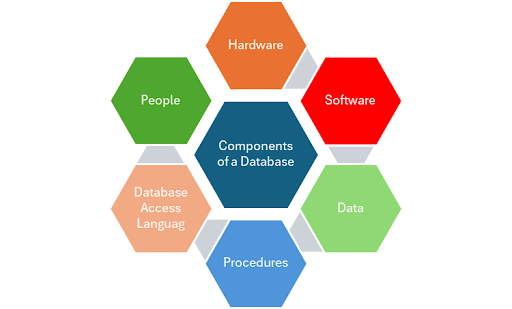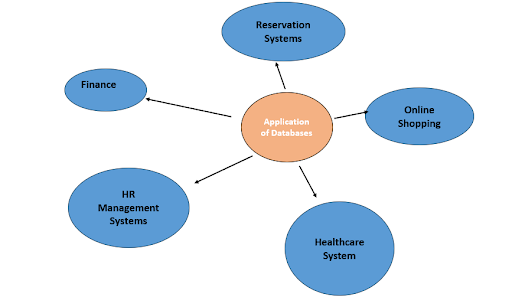Unlock The 6 components of a Database and Its Core Building Blocks In DBMS
Table of Contents

- jaro education
- 30, September 2023
- 4:00 pm
In the data-driven era we live in today, the value of databases cannot be underestimated. Every day, organisations—whether small or large—work with vast amounts of data. Managing such large volumes of data is crucial for the success or failure of a business. But what does a database really consist of? How do they play such an important role in any business, and how can they be managed? Let’s learn about the six major components of a database, along with their applications and more. With this comprehensive blog, you will also understand how you can pursue a career in this field. Let’s get started.
What is a Database?
A database is a collection of logically related information organised in such a way that it is easily accessible, manageable, and updatable. Databases are most commonly accessed from electronic systems, i.e., computers, and are controlled by a Database Management System (DBMS). The database administrator (DBA) is the one who is responsible for managing the databases, including database security, access control, backup, and disaster recovery.
What is the Important Role of a Database in an Enterprise?
Enterprises typically use two types of databases: internal and external. Internal databases are all about storing data related to operations and warehouses. They refer to databases that are actively used in the operations of the business, such as accounting, sales, finance, and HR.
Data warehouses contain data collected from several sources, and the data contained within is generally not used for regular business activities. Instead, data warehouses are usually utilised for business intelligence purposes. On the other hand, external databases are outside an organisation, typically accessed over the Internet and owned by other organisations. The best example of an external database is the SEC database, which stores complete information about an organisation.
What Are the 6 Components of a Database?
Enterprises typically use two types of databases: internal and external. Internal databases are all about storing data related to operations and warehouses. They refer to databases that are actively used in the operations of the business, such as accounting, sales, finance, and HR.
Data warehouses contain data collected from several sources, and the data contained within is generally not used for regular business activities. Instead, data warehouses are usually utilised for business intelligence purposes. On the other hand, external databases are outside an organisation, typically accessed over the Internet and owned by other organisations. The best example of an external database is the SEC database, which stores complete information about an organisation.

Hardware
Hardware is one of the components of a database, which refers to the physical parts of the computer. The most visible part of any information system, hardware includes the equipment used to gather data, perform calculations, and provide output. Common examples of hardware are computers, scanners, and printers. For example, when we run Oracle or MySQL on our personal computers, the computer’s hard disk, keyboard, RAM, and ROM become part of the DBMS hardware. Understanding the components of a database like hardware is essential for easy and smooth data management.
Software
Software is the heart of any component of a database Management System. It refers to the collection or set of programs or instructions that enable a machine to perform tasks demanded by the user. Software contains all classes of programs, procedures, and routines associated with the operation of a computer system. Examples of DBMS software include PostgreSQL, MySQL, SQL Server, Microsoft Access, FileMaker, Oracle, dBASE, Clipper, and FoxPro. All these software are also critical components of a database that ensures seamless operations.
Data
Data is one of the vital components of a database consisting of values stored in a database and is considered the raw material used to produce information. Examples of data stored in a database include structured, unstructured, and semi-structured data. Structured data has a highly specific description and is stored in a recognized format according to certain rules. In contrast, unstructured data consists of various types of data clustered together in their native format. For instance, when you store your name in the database, the DBMS ensures that it also records the time the name was stored, the size of the name, and whether it is related to other data.
Procedures
Procedures are general instructions that are applied in a database management system to fetch results. These include instructions for setting up and installing a DBMS, logging in and out, managing databases, taking backups, and generating reports. Procedures can also assist with data validation, access control, and reducing network traffic between clients and DBMS servers. Procedures are essential components of a database, guiding users on how to interact with the system.
Database Access Language
The Database Access Language is another important component of a database, facilitating user interaction with the data. It allows users to write commands to perform desired operations on the data stored in a database. This language enables users to access, update, or delete data. Examples of database languages include SQL (Structured Query Language), My Access, and Oracle.
People
DBMS is concerned with the line or rather the users who operate and also control the databases and conduct various operations on them. They include database administrators, software developers, and end-users.
What is a Database Management System (DBMS)?
A Database Management System (DBMS) is a set of programs that allows users to manipulate, store, report and relate data within databases. Data redundancy is one reason why a DBMS is used, as it provides assured data management and helps limit data integrity issues. The relational model, which uses tables to display data, is the most common component of DBMS structure. It includes rows, columns, and tables that simplify content retrieval. The DBMS itself acts as an overarching system that integrates all components of a database, ensuring efficient data handling.
Starting a career with a strong foundation in DBMS and SQL is highly beneficial, as many software applications and systems rely on databases to store and manage data. Proficiency in these areas opens up opportunities in roles such as database administrator, data analyst, data engineer, and software developer, all of which require a solid understanding of the components of a database.
Applications of a Database
A Database Management System (DBMS) is a set of programs that allows users to manipulate, store, report and relate data within databases. Data redundancy is one reason why a DBMS is used, as it provides assured data management and helps limit data integrity issues. The relational model, which uses tables to display data, is the most common component of DBMS structure. It includes rows, columns, and tables that simplify content retrieval. The DBMS itself acts as an overarching system that integrates all components of a database, ensuring efficient data handling.
Starting a career with a strong foundation in DBMS and SQL is highly beneficial, as many software applications and systems rely on databases to store and manage data. Proficiency in these areas opens up opportunities in roles such as database administrator, data analyst, data engineer, and software developer, all of which require a solid understanding of the components of a database.

When used appropriately, databases can serve as crucial resources for organisations across various sectors attempting to organise their data better. Some common applications include:
- Reservation Systems: DBMS enables train and air travel reservations, manages timetables, and controls flight or train departures and delays.
- Online Shopping: The growth of eCommerce has led to increased dependence on DBMS for managing orders, deliveries, billing, and tracking information.
- Healthcare Systems: DBMS prevails in healthcare for structuring records and managing appointments, treatment histories, fee records, and invoices.
- Finance: DBMS applications enhance accounting functions and are widely used in the banking industry.
- HR Management Systems: DBMS helps HR executives store and manage employee information, including names, designations, salaries, and insurance details.
Future of Databases
With the increasing volume of data, the evolution of future databases is necessary. People are expected to access databases from anywhere in the world without limitations on data volume. As a result, more organisations are likely to move their data to the cloud, with the percentage of data stored in the cloud having doubled from 2015 to 2024.
As data volumes increase, so do cyber security threats. Organisations will be expected to deploy enhanced security solutions alongside their cloud environments, ensuring databases are accessible only to authorised users.
How Can Professionals Advance Their Careers in Database Management?
The database management career path typically begins with obtaining a degree in information technology or an online computer science degree. And what can be better than having a degree from one of the most renowned universities? i.e., Manipal University Jaipur. Let’s understand their programme in detail.
Master of Computer Applications (MCA) Online Degree Programme from Manipal University Jaipur
-
- Course Duration: 24 Months
- Mode: Online
Programme Highlights
- Designed for immersive learning
- Advanced digital learning platform
- Dedicated course mentors and insights from industry leaders
- Career counselling and placement assistance
- Hands-on training in cloud, big data, and machine learning
- Exposure to new job opportunities
- Free access to Coursera and Google Cloud Computing Foundations
How Can Jaro Education Help You Achieve Your Career Goals?
Jaro Education—a leading online higher education and upskilling company—offers tailored career guidance and counselling for individuals who are uncertain about their career goals. Our dedicated team of professionals is committed to enhancing the learning experience for all students.
When you enrol in a certification course or an online degree programme through Jaro Education, you gain access to the Jaro Advantage, which includes:
- Unparalleled career guidance and support
- Dedicated student support
- Immersive and lifelong learning experiences
- Learn from the best-suited academic, faculty, and industry mentors
- Be a part of discussions and forums for enhanced learning
Final Thoughts
Undoubtedly, the database is the backbone of any industry that is not going anywhere. Without a strong database, a company is no longer able to make informed decisions, track performance effectively, or harness valuable insights that drive growth and innovation. So, if you’re ready to build your thriving career in this sector, doing the Master of Computer Applications (MCA) Online Degree Programme from Manipal University Jaipur can be the wisest decision. Not only will this course help you to understand all you need to know about DBMS, but other fields might fascinate you. To take the fullest benefit of this programme, enrol through Jaro Education and walk on your way to success.
Frequently Asked Questions
The component modules of DBMS are hardware, software, data, procedures, database access language, and the database management system (DBMS). All this is crucial for the proper functioning of the database, thus enabling the users to explore it in the best possible way.
The DBMS manages data by reducing redundancy, maintaining the integrity of data, and providing a way to store and retrieve it in a structured manner. Users can perform operations like data handling, data reporting, and access control, which makes it very easy to manage a vast amount of data.
There are several database management career opportunities you can either look at or enrol in, among other positions like software developers, data engineers, and administrators. Database management and querying with SQL are two of the essential skills required for these jobs as most organisations’ data is stored using databases, which they mainly use for data management.
Advancing your career in database management typically involves obtaining relevant educational qualifications, such as a degree in information technology or computer science. Additionally, pursuing certifications and gaining hands-on experience with DBMS technologies can enhance your skills and job prospects. Programs like the Online Master of Computer Applications (MCA) can provide valuable knowledge and training in this field.








